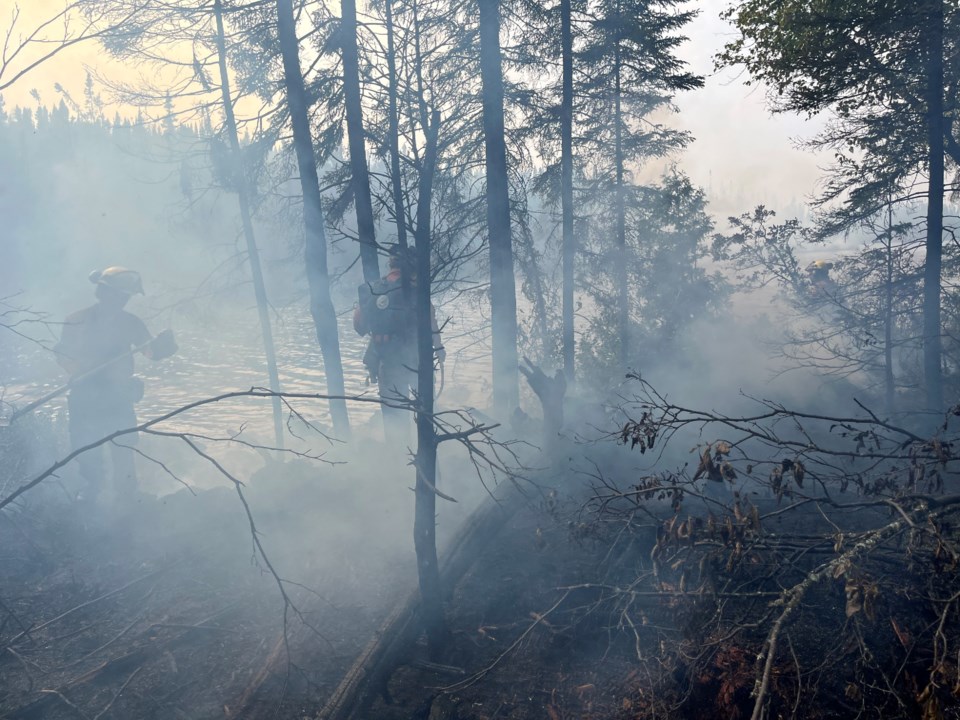THUNDER BAY – With forest fire season approaching it's easy to forget the negative effects of smoke exposure from a vast number of forests burning down all around Ontario.
For those front-line forest firefighters, a recent study into the harmful effects of inhaling smoke has union members actively trying to get the Ontario government to implement new health and safety guidelines.
“We have so many issues that we're trying to address simultaneously with a fire program that has been falling apart for years. This is one of those issues that hit closer to home because it affects us all immediately, but it also affects us in our future,” said Noah Freedman, vice president of OPSEU Local 703, in an interview with Newswatch.
Freedman co-wrote a Joint Health and Safety Committee report to the Ministry of Natural Resources and Forestry, which lays out four recommendations that would ensure MNRF creates policies that recognize their employee safety from smoke exposure.
However, Freedman feels his recommendations were dismissed by the MNRF.
In an email (provided by Freedman) sent to MNRF’s Health and Safety Committee, general manager Stephenie Maragna informed the committee that the MNRF is working on “a formal program to address concerns associated with smoke exposure.”
Additionally, the email also stated that information about smoke exposure had been added to the updated orientation package.
According to Freedman, the orientation package, which was updated in the summer of 2023, acknowledges smoke exposure can be dangerous, but there were no other details about how dangerous.
"We presented very simple recommendations and one of the things that was alarming off the bat, in 2007 is when we see the first kind of acknowledgment that smoke exists," he said.
"There was a safety memo titled 'Working Near Smoke.' It basically said we have identified the hazards of smoke and you should do your best to stay out of the smoke, but it never said anything about what was in it.”
Freedman and the Health and Safety Committee found during their research that forest firefighters are exposed to several toxins including carbon monoxide, hydrocarbons, formaldehyde, acrolein, particulate matter, and peat.
Although the recommendations report lists several extreme toxins in smoke, Freedman addressed one particular common toxin that MNRF’s training manuals state has “no long-term health effects.”
“They talked specifically about carbon monoxide. One of the things they said was even in extreme dosages, there are no long-term health effects to carbon monoxide exposure.
"I said, why don't I verify this? And then you start seeing articles coming out in 2006 and they're showing moderate to severe carbon monoxide exposure in single instances increases the risk of cardiovascular mortality by massive numbers,” said Freedman, who also reflected on the extreme smoke billowing over the skies this past summer.
Wildfire smoke contains particulate matter such as dust, dirt, soot, ash, and liquid droplets.
“In my research into these, in these scientific articles, particulate matter is so dangerous -- because it's so small -- that it goes through the alveoli into the bloodstream and then can go to any part of the body and infect any organ. What's particularly fascinating is that something carcinogenic like polycyclic aromatic hydrocarbons, which the government acknowledges are dangerous, well forest fires are the number one producer of these chemicals.”
Freedman also pointed out the equipment that forest firefighters use is different from urban firefighters. Forest firefighters do not use respirators. The orientation package recommends they use a dry fabric covering to filter out the smoke.
“Bandanas are an inadequate form of respiratory protection against the particulate and gaseous compounds generated by a forest fire,” stated Freedman, quoting from a 1994 study from the National Institute of Occupational Safety and Health of Firefighters.
“So even if you don't have a respirator and even if you're just using an N95 mask, like everybody on the street in the city, you're not only stopping that particulate matter, but we're actually preventing those pathogens that are bound to them from reaching the bloodstream and infecting organs.”
Freedman's recommendations want the MNRF to acknowledge the specific hazards, address any health and safety that may arise from their acknowledgment, be more transparent about committees that deal with health and safety issues, and address the health complications that arise from smoke exposure.
Newswatch reached out to the MNRF for clarification.
An MNRF spokesperson emailed a statement that read, “The Ministry takes the safety of our fire crews and other emergency support personnel very seriously. Our health and safety team provides ongoing training, reminders, and guidance while addressing any concerns. AFFES has collaborated with external stakeholders and fire agencies to gather data on wildland smoke exposure. This will help us understand risks better and use established safety processes effectively.
“Meanwhile, we've put procedures in place to minimize smoke exposure hazards for our front-line fire ranger staff. The Ministry of Labour, Immigration, Training, and Skills Development works with us to assess occupational health and safety matters, including legislative coverage.”
